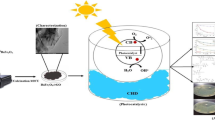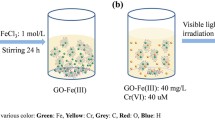Abstract
Due to its unique properties, the potential application of graphene oxide (GO) in treating environmental pollution has attracted wide attention. In this study, the UV-light catalyzed photoreduction of Cr(VI) by GO was assessed as well as its adsorption toward Cr(VI), and FTIR and XPS techniques were adopted to reveal the underlying mechanisms. The surfaces of GO were negatively charged across the pH range examined. Therefore, the increase in pH resulted in the decrease in Cr(VI) adsorption due to the enhancement in repulsion between Cr(VI) and GO surfaces. The kinetic studies showed that the Cr(VI) adsorption proceeded quickly during the 0–24 h stage, followed by a slow process until to the end of reaction (96 h). Additionally, the kinetic data could be properly described with the pseudo-first-order rate equation (R2 = 0.9754). With the UV-light irradiation, Cr(VI) reduction in the presence of 0.5 g L−1 GO was observed with the concentration of Cr(VI) decreased from 0.1 mM to zero within 12 h at pH 3.0, while which would be suppressed as the pH increased. The addition of EDTA could enhance the photocatalytic Cr(VI) reduction due to the consumption of the photogenerated holes (h+), leaving more Cr(III) species present in solution. The generation of h+ was further confirmed by the complete photodegradation of 4-CP during 48 h. Moreover, the changes in FTIR and XPS spectrum of GO before and after reaction indicated the oxidization of epoxy and hydroxyl groups by holes or reduction by electrons was involved in the photoreaction. The photoreduction of Cr(VI) could was also observed in an oxisol with the existence of GO, with the disappearance of 0.1 mM of aqueous Cr(VI) at pH 4.40 after 36 h. The results above could enhance our understanding on the essence of photoreactivity of GO, and indicated that the potential release of GO into soil environments would be helpful to eliminate the risk posed by Cr(VI) through the UV-light irradiated photocatalytic reduction.







Similar content being viewed by others
References
Akhavan, O., & Ghaderi, E. (2010). Toxicity of graphene and graphene oxide nanowalls against bacteria. ACS Nano, 4, 5731–5736.
Antoniadis, V., Polyzois, T., Golia, E. E., Spyridon, A., & Petropoulos, S. A. (2017). Hexavalent chromium availability and phytoremediation potential of Cichorium spinosum as affect by manure, zeolite and soil ageing. Chemosphere, 171, 729–734.
Bartlett, R. J., & James, B. R. (1999). Chromium. In D. L. Sparks (Ed.), Methods of soil analysis (pp. 683–701). Madison: Soil Sci Soc Am.
Beukes, J. P., Du Preez, S. P., Van Zyl, P. G., Paktunc, D., & Cramer, M. (2017). Review of Cr(VI) environmental practices in the chromite mining and smelting industry—relevance to development of the Ring of Fire, Canada. Journal of Cleaner Production, 165, 874–889.
Cai, Y. Q., & Feng, Y. P. (2016). Review on charge transfer and chemical activity of TiO2: Mechanism and applications. Progress in Surface Science, 91, 183–202.
Cao, X. H., Guo, J., Mao, J. D., & Lan, Y. Q. (2011). Adsorption and mobility of Cr(III)–organic acid complexes in soils. Journal of Hazardous Materials, 192, 1533–1538.
Cardona, M. P., Li, M. Y., Li, W., McCall, J., Wang, D. W., Li, Y., & Yang, C. (2018). The role of graphene as an overlayer on nanostructured hematite photoanodes for improved solar water oxidation. Materials Today Energy, 8, 8–14.
Desimoni, E., Malitesta, C., Zambonin, P. G., & Rivière, J. C. (1988). An x-ray photoelectron spectroscopic study of some chromium–oxygen systems. Surface and Interface Analysis, 13, 173–179.
Dhal, B., Thatoi, H. N., Das, N. N., & Pandey, B. D. (2013). Chemical and microbial remediation of hexavalent chromium from contaminated soil and mining/metallurgical solid waste: A review. Journal of Hazardous Materials, 250-251, 272–291.
Dreyer, D. R., Park, S., Bielawski, C. W., & Ruoff, R. S. (2010). The chemistry of graphene oxide. Chemical Society Reviews, 39, 228–240.
Fernández, P. M., Viñarta, S. C., Bernal, A. R., Cruz, E. L., & Figueroaac, L. I. C. (2018). Bioremediation strategies for chromium removal: Current research, scale-up approach and future perspectives. Chemosphere, 208, 139–148.
Gaberell, M., Chin, Y. P., Hug, S. J., & Sulzberger, B. (2003). Role of dissolved organic matter composition on the photoreduction of Cr(VI) to Cr(III) in the presence of iron. Environmental Science & Technology, 37, 4403–4409.
Hao, Y., Ma, C. X., Zhang, Z. T., Song, Y. H., Cao, W. D., Guo, J., Zhou, G. P., Rui, Y. K., Liu, L. M., & Xing, B. S. (2018). Carbon nanomaterials alter plant physiology and soil bacterial community composition in a rice-soil-bacterial ecosystem. Environmental Pollution, 232, 123–136.
Hsu, H. T., Chen, S. S., Tang, Y. F., & Hsi, H. C. (2013). Enhanced photocatalytic activity of chromium(VI) reduction and EDTA oxidization by photoelectrocatalyis combining cationic exchange membrane. Journal of Hazardous Materials, 248-249, 97–106.
Jiang, X., Nisar, J., Pathak, B., Zhao, J. J., & Ahuja, R. (2013). Graphene oxide as a chemically tunable 2-D material for visible-light photocatalyst applications. Journal of Catalysis, 299, 204–209.
Jiang, B., Wang, X. L., Liu, Y. K., Wang, Z. H., Zheng, J. T., & Wu, M. B. (2016). The roles of polycarboxylates in Cr(VI)/sulfite reaction system: Involvement of reactive oxygen species and intramolecular electron transfer. Journal of Hazardous Materials, 304, 457–466.
Kumar, V., Kim, K. H., Park, J. W., Hong, J., & Kumar, S. (2017). Graphene and its nanocomposite as a platform for environmental application. Chemical Engineering Journal, 315, 210–232.
Lazareva, A., & Keller, A. K. (2014). Estimating potential life cycle releases of engineered nanomaterials from wastewater treatment plants. ACS Sustainable Chemistry & Engineering, 2, 1656–1665.
Lonkar, S. P., Pillai, V., & Abdala, A. (2019). Solvent-free synthesis of ZnO-graphene nanocomposite with superior photocatalytic activity. Applied Surface Science, 465, 1107–1113.
Matsumoto, Y., Koinuma, M., Ida, S., Hayami, S., Taniguchi, T., Hatakeyama, K., Tateishi, H., Watanabe, Y., & Amano, S. (2011). Photoreaction of graphene oxide nanosheets in water. Journal of Physical Chemistry C, 115, 19280–19286.
Meichtry, J. M., Colbeau-Justin, C., Custo, G., & Litter, M. I. (2014). TiO2-photocatalytic transformation of Cr(VI) in the presence of EDTA: Comparison of different commercial photocatalysts and studies by time resolved microwave conductivity. Applied Catalysis B: Environmental, 144, 189–195.
Moffat, T. P., Latanision, R. M., & Ruf, R. R. (1995). An X-ray photoelectron spectroscopy study of chromium-metalloid alloys—III. Electrochimica Acta, 40, 1723–1724.
Parkinson, G. S. (2016). Iron oxide surfaces. Surface Science Reports, 71, 272–365.
Putri, L. K., Tan, L. L., Ong, W. J., Chang, W. S., & Chai, S. P. (2016). Graphene oxide: Exploiting its unique properties towards visible-light-driven photocatalysis. Applied Materials Today, 4, 9–16.
Ramsey, J. D., Xia, L., Kendig, M. W., & McCreery, R. L. (2001). Raman spectroscopic analysis of the speciation of dilute chromate solutions. Corrosion Science, 43, 1557–1572.
Raptis, S., Gasparatos, D., Economou-Eliopoulos, M., & Petridis, A. (2018). Chromium uptake by lettuce as affected by the application of organic matter and Cr(VI)-irrigation water: Implications to the land use and water management. Chemosphere, 210, 597–606.
Ribao, P., Rivero, M. J., & Ortiz, I. (2018). Enhanced photocatalytic activity using GO/TiO2 catalyst for the removal of DCA solutions. Environmental Science and Pollution Research, 25, 34893–34902.
Sajjad, S., Khan Leghari, S. A., & Iqbal, A. (2017). Study of graphene oxide structural features for catalytic, antibacterial, gas sensing, and metals decontamination environmental applications. ACS Applied Materials & Interfaces, 9, 43393–43414.
Satuf, M. L., Brandi, R. J., Cassano, A. E., & Alfano, O. M. (2008). Photocatalytic degradation of 4-cholrophenol: A kinetic study. Applied Catalysis B: Environmental, 82, 37–49.
Shahid, M., Shamshad, S., Rafiq, M., Khalid, S., Bibi, I., Nabeel, N. K., Dumat, C., & Rashid, M. I. (2017). Chromium speciation, bioavailability, uptake, toxicity and detoxification in soil–plant system: A review. Chemosphere, 178, 513–533.
Shan, X. L., Guo, X. T., Yin, Y. Y., Mao, Y., & Dong, H. (2017). Surface modification of graphene oxide by goethite with enhanced tylosin photocatalytic activity under visible light irradiation. Colloids and Surfaces A-Physicochemical and Engineering Aspects, 520, 420–427.
Sleigh, C., Pijpers, A. P., Jaspers, A., Coussens, B., & Meier, R. J. (1996). On the determination of atomic charge via ESCA including application to organometallics. Journal of Electron Spectroscopy and Related Phenomena, 77, 41–57.
Sun, M., & Li, J. H. (2018). Graphene oxide membranes: Functional structures, preparation and environmental applications. Nano Today, 20, 121–137.
Vinuth, M., Naik, H. S. B., & Manjanna, J. (2015). Remediation of hexavalent chromium from aqueous solution using clay mineral Fe(II)-montmorillonite: Encompassing anion exclusion impact. Applied Surface Science, 357, 1244–1250.
Wang, X. X., Fan, Q. H., Chen, Z. S., Wang, Q., Li, J. X., Hobiny, A., Alsaedi, A., & Wang, X. K. (2016a). Surface modification of graphene oxides by plasma techniques and their application for environmental pollution cleanup. The Chemical Record, 16, 295–318.
Wang, X. X., Yu, S. J., Jin, J., Wang, H. Q., Alharbi, N. S., Alsaedi, A., Hayat, T., & Wang, X. K. (2016b). Application of graphene oxides and graphene oxide-based nanomaterials in radionuclide removal from aqueous solutions. Science Bulletin, 61, 1583–1593.
Wang, X. X., Liu, Y., Pang, H. W., Yu, S. J., & Wang, X. K. (2018). Effect of graphene oxide surface modification on the elimination of Co(II) from aqueous solutions. Chemical Engineering Journal, 344, 380–390.
Xie, Y., Chen, C. L., Ren, X. M., Wang, X. X., Wang, H. Y., & Wang, X. K. (2019). Emerging natural and tailored materials for uranium-contaminated water treatment and environmental remediation. Progress in Materials Science, 103, 180–234.
Xiong, T., Yuan, X. Z., Wang, H., Leng, L. J., Li, H., Wu, Z. B., Jiang, L. B., Xu, R., & Zeng, G. M. (2018). Implication of graphene oxide in Cd-contaminated soil: A case study of bacterial communities. Journal of Environmental Management, 205, 99–106.
Yan, J. A., Xian, L. D., & Chou, M. Y. (2009). Structural and electronic properties of oxidized graphene. Physical Review Letters, 103, 086802.
Yang, J. W., Zhong, L. Y., & Liu, L. M. (2013). Coupling of tartaric acid-promoted soil dissolution and Cr(VI) reduction in an Oxisol. Journal of Geochemical Exploration, 125, 138–143.
Yoshinaga, M., Ninomiya, H., Aeorangejeb Al Hossain, M. M., Sudo, M., Akhand, A. A., Ahsan, N., Md Alim, A., Khalequzzaman, M. D., Iida, M., Yajima, I., Ohgami, N., & Kato, M. (2018). A comprehensive study including monitoring, assessment of health effects and development of a remediation method for chromium pollution. Chemosphere, 201, 667–675.
Zhou, G. X., Zhong, J., Zhang, H., Hu, X. H., Wu, J. L., Koratkard, N., & Shi, X. M. (2017). Influence of releasing graphene oxide into a clay sand: Physical and mechanical properties. RSC Advances, 7, 18060–18067.
Funding
This work was supported by the National Natural Science Foundation of China (grant no. 41671235).
Author information
Authors and Affiliations
Corresponding author
Ethics declarations
Conflict of Interest
The authors declare that they have no competing interests.
Additional information
Publisher’s Note
Springer Nature remains neutral with regard to jurisdictional claims in published maps and institutional affiliations.
Electronic supplementary material
ESM 1
(DOCX 252 kb)
Rights and permissions
About this article
Cite this article
Zhang, Y., Yang, J. UV-Light Catalyzed Reduction of Cr(VI) by Graphene Oxide and its Significance for Cr(VI) Transformation in an Oxisol. Water Air Soil Pollut 230, 103 (2019). https://doi.org/10.1007/s11270-019-4161-6
Received:
Accepted:
Published:
DOI: https://doi.org/10.1007/s11270-019-4161-6




